Abstract
Two patients (brother and sister, 41 and 39 yr of age, respectively) have been shown to have marked elevation of plasma triglycerides and chylomicrons, decreased low density lipoproteins (LDL) and high density lipoproteins (HDL), a type I lipoprotein phenotype, and a deficiency of plasma apolipoprotein C-II (apo C-II). The male patient had a history of recurrent bouts of abdominal pain often accompanied by eruptive xanthomas. The female subject, identified by family screening, was asymptomatic. Hepatosplenomegaly was present in both subjects. Analytical and zonal ultracentrifugation revealed a marked increase in triglyceride-rich lipoproteins including chylomicrons and very low density lipoproteins, a reduction in LDL, and the presence of virtually only the HDL3 subfraction. LDL were heterogeneous with the major subfraction of a higher hydrated density than that observed in plasma lipoproteins of normal subjects. Apo C-II levels, quantitated by radioimmunoassay, were 0.13 mg/dl and 0.12 mg/dl, in the male and female proband, respectively. A variant of apo C-II (apo C-IIPadova) with lower apparent molecular weight and more acidic isoelectric point was identified in both probands by two-dimensional gel electrophoresis. The marked hypertriglyceridemia and elevation of triglyceride-rich lipoproteins were corrected by the infusion of normal plasma or the injection of a biologically active synthesized 44-79 amino acid residue peptide fragment of apo C-II. The reduction in plasma triglycerides after the injection of the synthetic apo C-II peptide persisted for 13-20 d. These results definitively established that the dyslipoproteinemia in this syndrome is due to a deficiency of normal apo C-II. A possible therapeutic role for replacement therapy of apo C-II by synthetic or recombinant apo C-II in those patients with severe hypertriglyceridemia and recurrent pancreatitis may be possible in the future.
Full text
PDF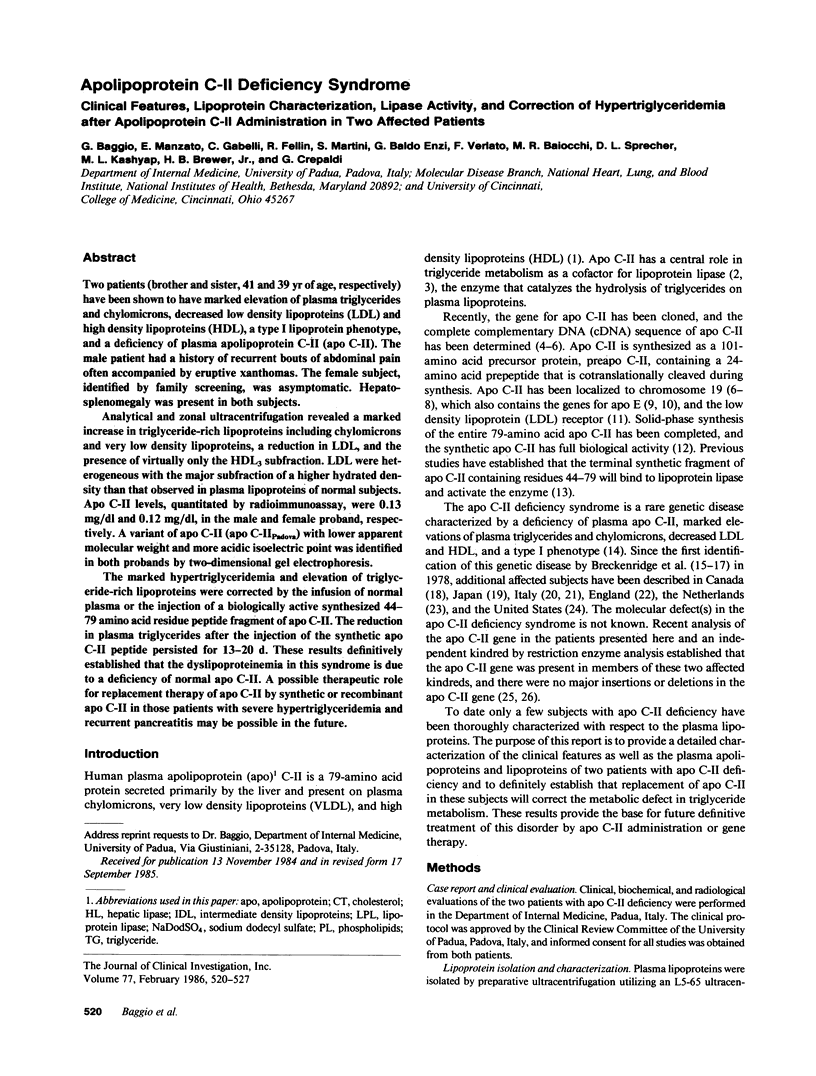
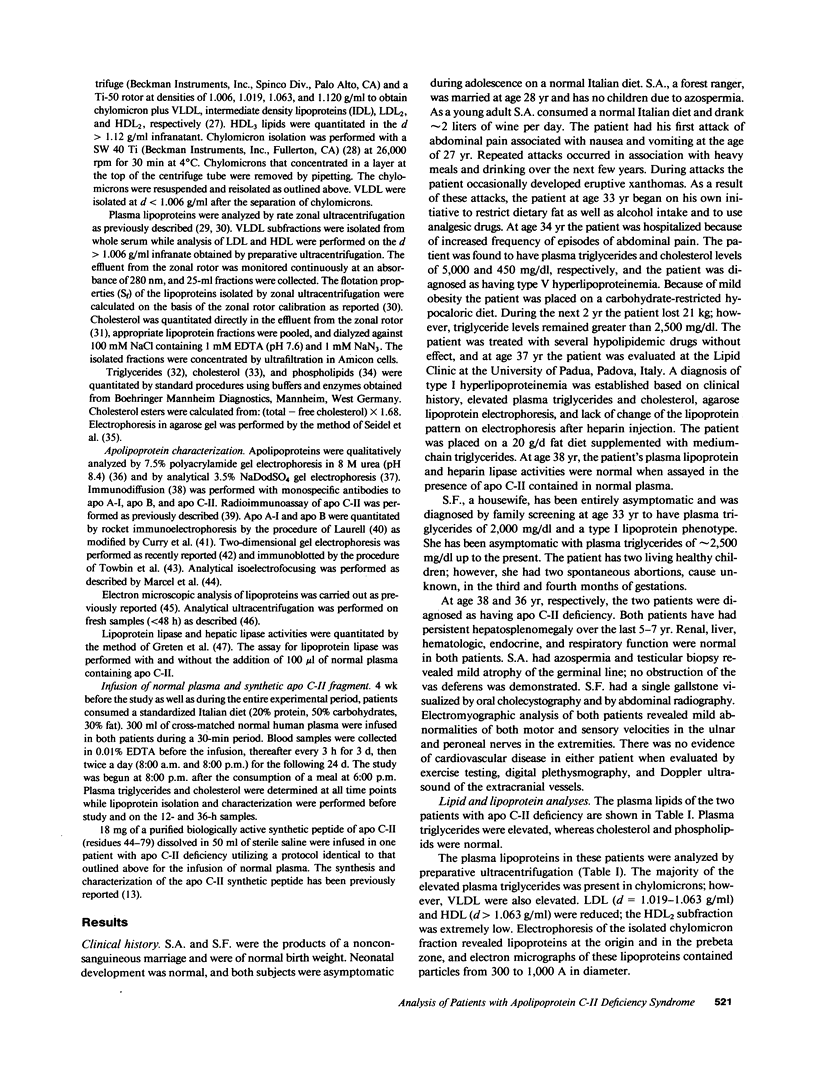
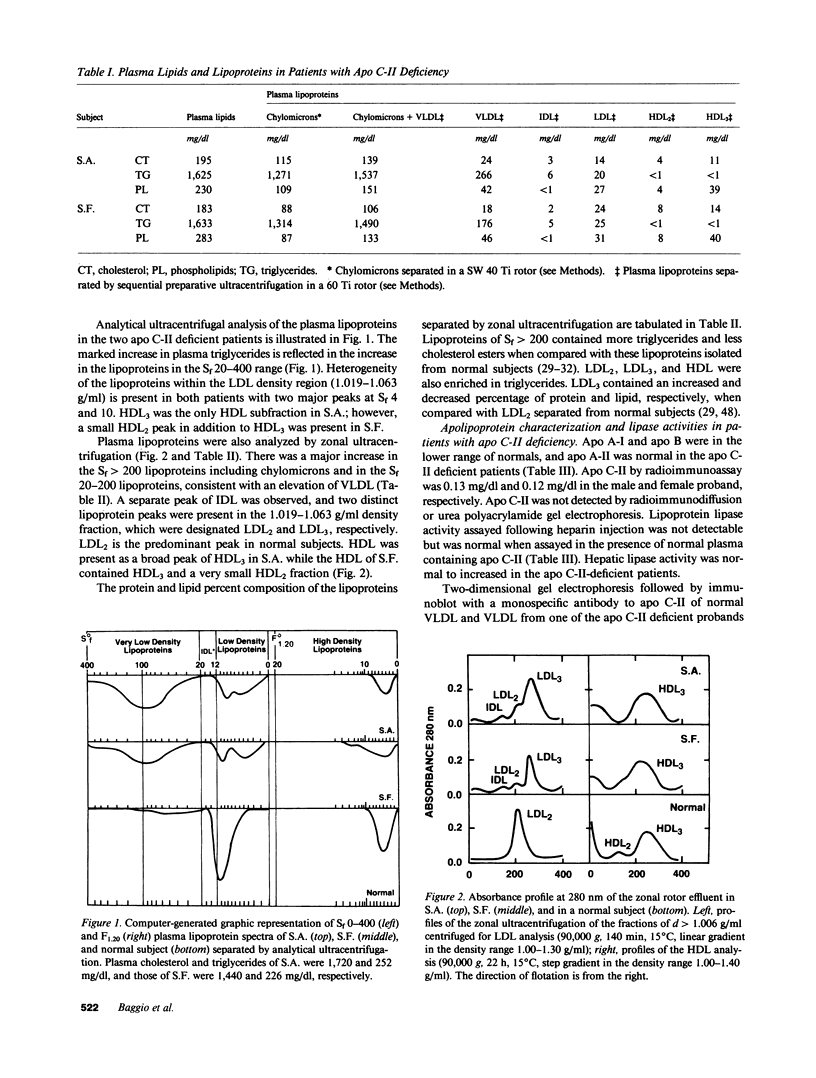
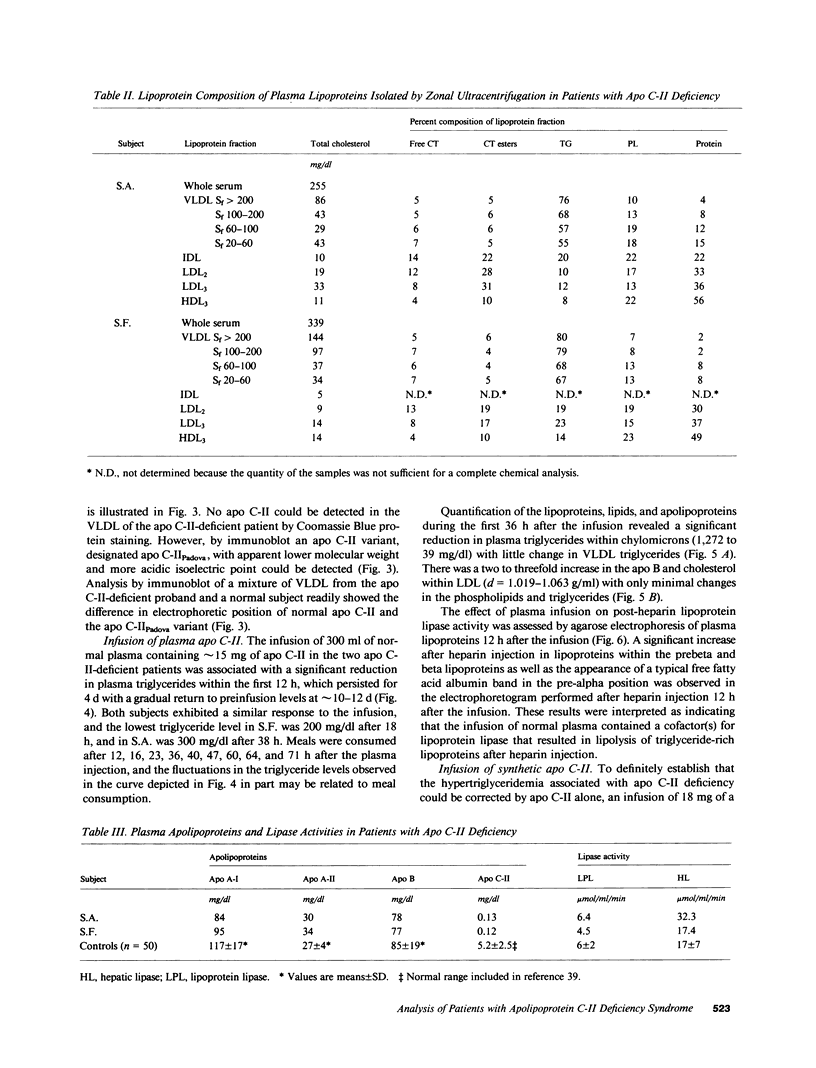
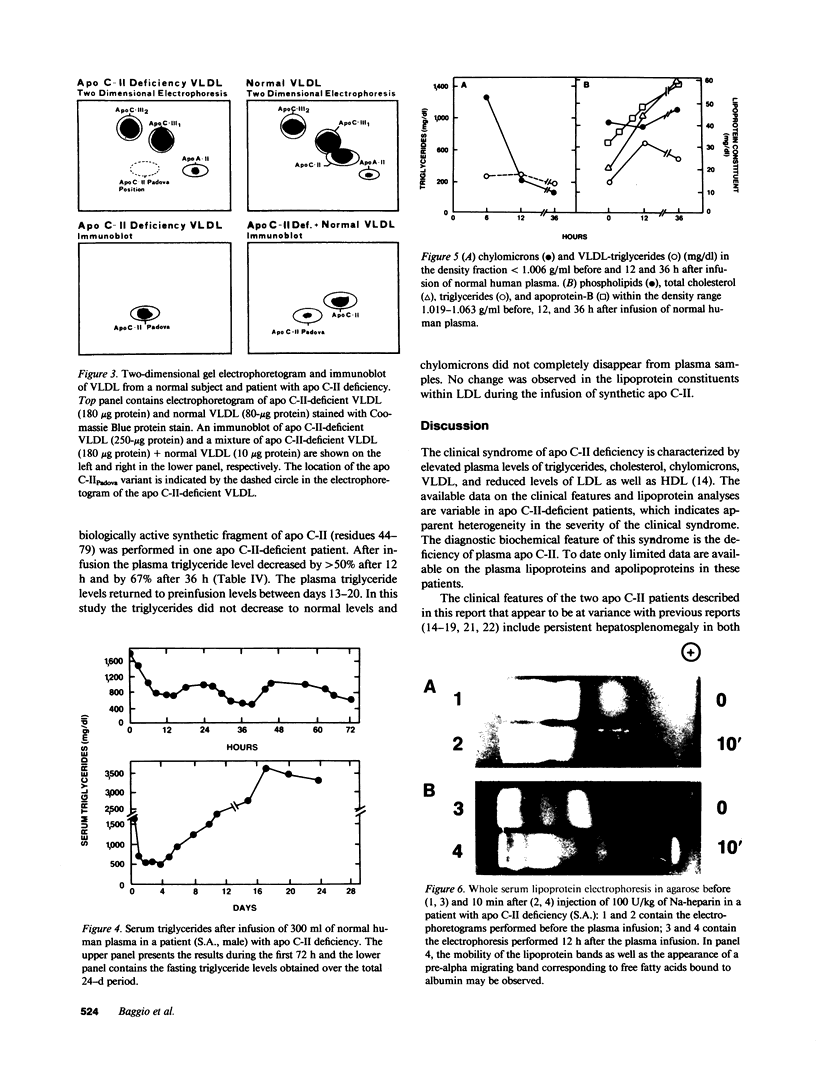
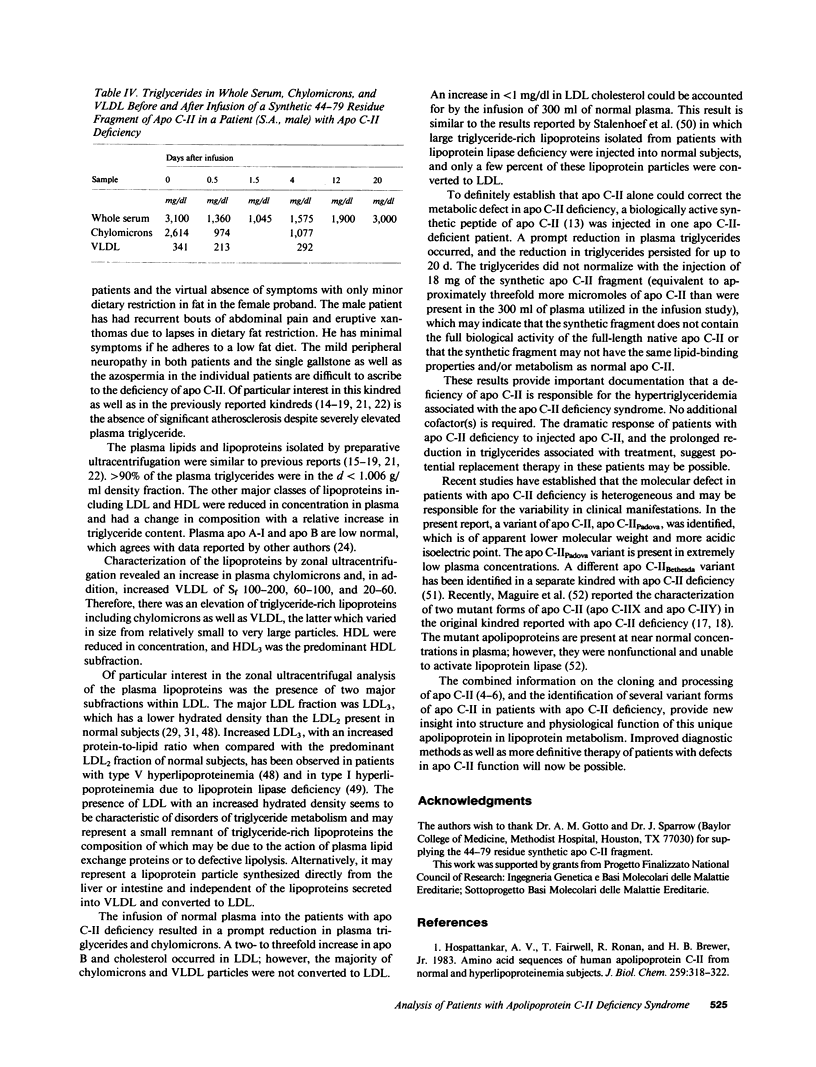
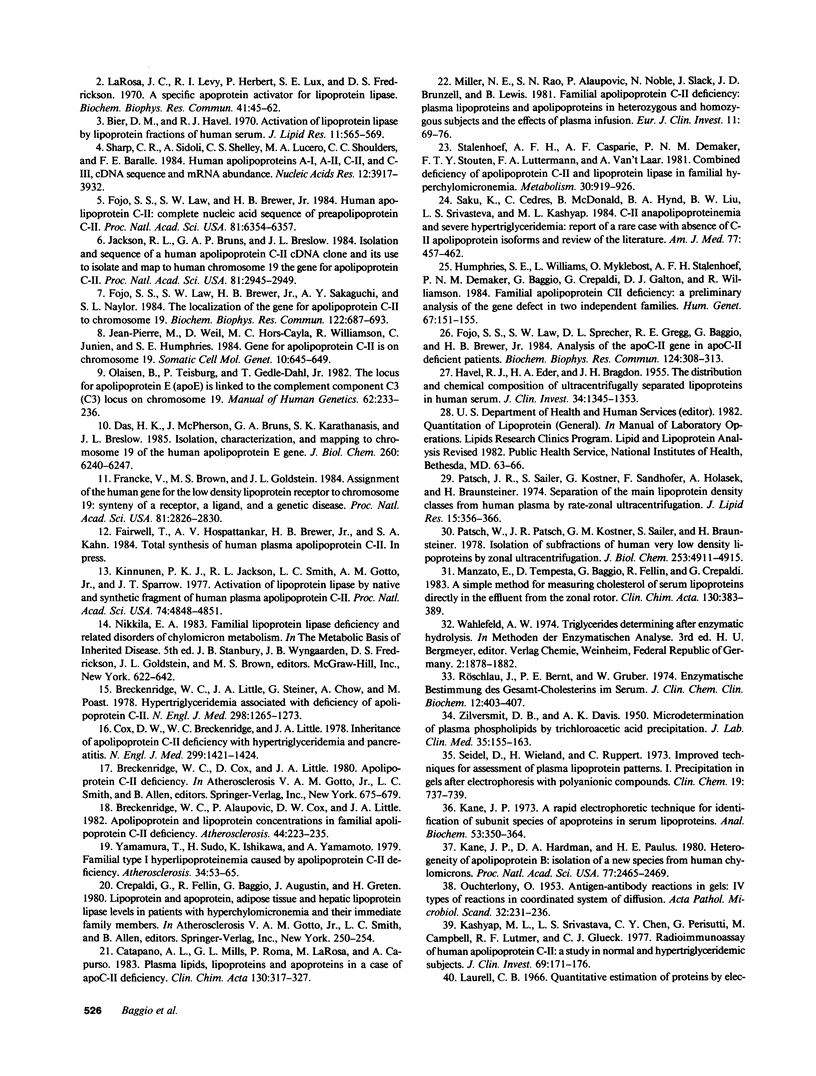
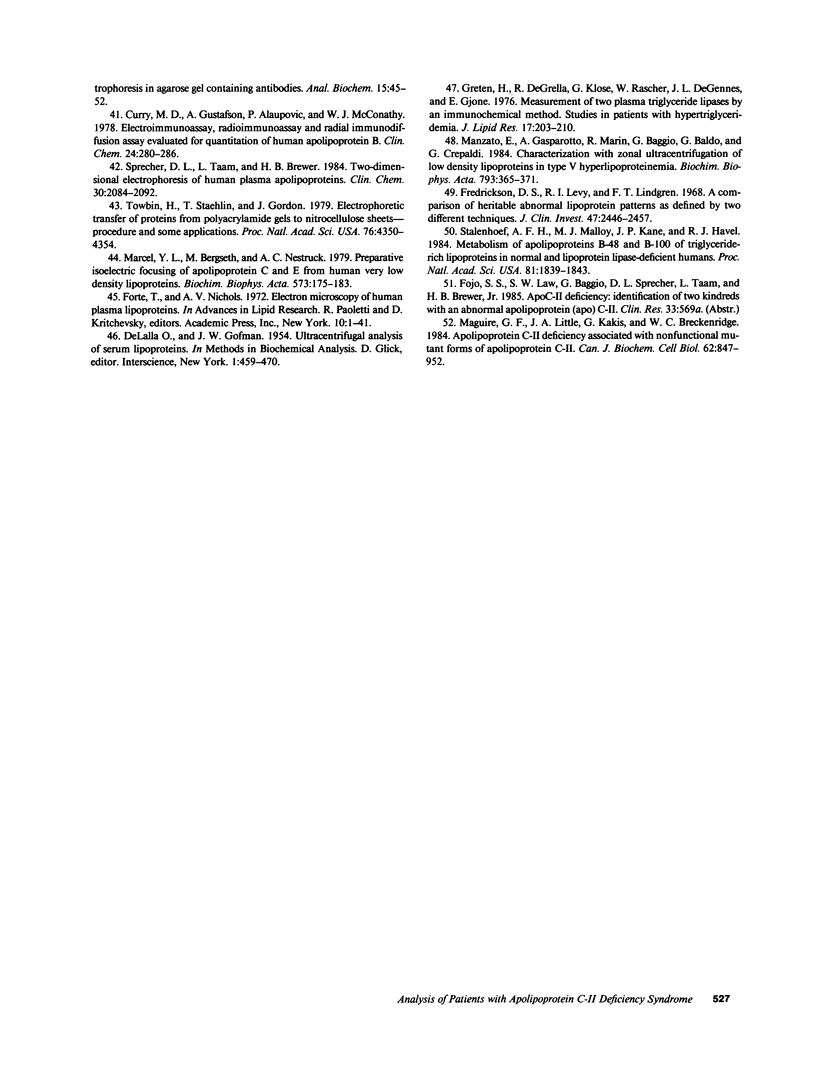
Images in this article
Selected References
These references are in PubMed. This may not be the complete list of references from this article.
- Bier D. M., Havel R. J. Activation of lipoprotein lipase by lipoprotein fractions of human serum. J Lipid Res. 1970 Nov;11(6):565–570. [PubMed] [Google Scholar]
- Breckenridge W. C., Alaupovic P., Cox D. W., Little J. A. Apolipoprotein and lipoprotein concentrations in familial apolipoprotein C-II deficiency. Atherosclerosis. 1982 Aug;44(2):223–235. doi: 10.1016/0021-9150(82)90116-2. [DOI] [PubMed] [Google Scholar]
- Breckenridge W. C., Little J. A., Steiner G., Chow A., Poapst M. Hypertriglyceridemia associated with deficiency of apolipoprotein C-II. N Engl J Med. 1978 Jun 8;298(23):1265–1273. doi: 10.1056/NEJM197806082982301. [DOI] [PubMed] [Google Scholar]
- Catapano A. L., Mills G. L., Roma P., La Rosa M., Capurso A. Plasma lipids, lipoproteins and apoproteins in a case of apo C-II deficiency. Clin Chim Acta. 1983 Jun 15;130(3):317–327. doi: 10.1016/0009-8981(83)90306-6. [DOI] [PubMed] [Google Scholar]
- Cox D. W., Breckenridge W. C., Little J. A. Inheritance of apolipoprotein C-II deficiency with hypertriglyceridemia and pancreatitis. N Engl J Med. 1978 Dec 28;299(26):1421–1424. doi: 10.1056/NEJM197812282992601. [DOI] [PubMed] [Google Scholar]
- Curry M. D., Gustafson A., Alaupovic P., McConathy W. J. Electroimmunoassay, radioimmunoassay, and radial immunodiffusion assay evaluated for quantification of human apolipoprotein B. Clin Chem. 1978 Feb;24(2):280–286. [PubMed] [Google Scholar]
- DE LALLA O. F., GOFMAN J. W. Ultracentrifugal analysis of serum lipoproteins. Methods Biochem Anal. 1954;1:459–478. doi: 10.1002/9780470110171.ch16. [DOI] [PubMed] [Google Scholar]
- Das H. K., McPherson J., Bruns G. A., Karathanasis S. K., Breslow J. L. Isolation, characterization, and mapping to chromosome 19 of the human apolipoprotein E gene. J Biol Chem. 1985 May 25;260(10):6240–6247. [PubMed] [Google Scholar]
- Fojo S. S., Law S. W., Brewer H. B., Jr Human apolipoprotein C-II: complete nucleic acid sequence of preapolipoprotein C-II. Proc Natl Acad Sci U S A. 1984 Oct;81(20):6354–6357. doi: 10.1073/pnas.81.20.6354. [DOI] [PMC free article] [PubMed] [Google Scholar]
- Fojo S. S., Law S. W., Brewer H. B., Jr, Sakaguchi A. Y., Naylor S. L. The localization of the gene for apolipoprotein C-II to chromosome 19. Biochem Biophys Res Commun. 1984 Jul 31;122(2):687–693. doi: 10.1016/s0006-291x(84)80088-1. [DOI] [PubMed] [Google Scholar]
- Fojo S. S., Law S. W., Sprecher D. L., Gregg R. E., Baggio G., Brewer H. B., Jr Analysis of the apoC-II gene in apoC-II deficient patients. Biochem Biophys Res Commun. 1984 Oct 15;124(1):308–313. doi: 10.1016/0006-291x(84)90953-7. [DOI] [PubMed] [Google Scholar]
- Forte T., Nichols A. V. Application of electron microscopy to the study of plasma lipoprotein structure. Adv Lipid Res. 1972;10:1–41. [PubMed] [Google Scholar]
- Francke U., Brown M. S., Goldstein J. L. Assignment of the human gene for the low density lipoprotein receptor to chromosome 19: synteny of a receptor, a ligand, and a genetic disease. Proc Natl Acad Sci U S A. 1984 May;81(9):2826–2830. doi: 10.1073/pnas.81.9.2826. [DOI] [PMC free article] [PubMed] [Google Scholar]
- Fredrickson D. S., Levy R. I., Lindgren F. T. A comparison of heritable abnormal lipoprotein patterns as defined by two different techniques. J Clin Invest. 1969 Nov;47(11):2446–2457. doi: 10.1172/JCI105927. [DOI] [PMC free article] [PubMed] [Google Scholar]
- Greten H., DeGrella R., Klose G., Rascher W., de Gennes J. L., Gjone E. Measurement of two plasma triglyceride lipases by an immunochemical method: studies in patients with hypertriglyceridemia. J Lipid Res. 1976 May;17(3):203–210. [PubMed] [Google Scholar]
- HAVEL R. J., EDER H. A., BRAGDON J. H. The distribution and chemical composition of ultracentrifugally separated lipoproteins in human serum. J Clin Invest. 1955 Sep;34(9):1345–1353. doi: 10.1172/JCI103182. [DOI] [PMC free article] [PubMed] [Google Scholar]
- Hospattankar A. V., Fairwell T., Ronan R., Brewer H. B., Jr Amino acid sequence of human plasma apolipoprotein C-II from normal and hyperlipoproteinemic subjects. J Biol Chem. 1984 Jan 10;259(1):318–322. [PubMed] [Google Scholar]
- Humphries S. E., Williams L., Myklebost O., Stalenhoef A. F., Demacker P. N., Baggio G., Crepaldi G., Galton D. J., Williamson R. Familial apolipoprotein CII deficiency: a preliminary analysis of the gene defect in two independent families. Hum Genet. 1984;67(2):151–155. doi: 10.1007/BF00272990. [DOI] [PubMed] [Google Scholar]
- Jackson C. L., Bruns G. A., Breslow J. L. Isolation and sequence of a human apolipoprotein CII cDNA clone and its use to isolate and map to human chromosome 19 the gene for apolipoprotein CII. Proc Natl Acad Sci U S A. 1984 May;81(10):2945–2949. doi: 10.1073/pnas.81.10.2945. [DOI] [PMC free article] [PubMed] [Google Scholar]
- Jeanpierre M., Weil D., Hors-Cayla M. C., Williamson R., Junien C., Humphries S. E. Gene for apolipoprotein CII is on human chromosome 19. Somat Cell Mol Genet. 1984 Nov;10(6):645–649. doi: 10.1007/BF01535231. [DOI] [PubMed] [Google Scholar]
- Kane J. P. A rapid electrophoretic technique for identification of subunit species of apoproteins in serum lipoproteins. Anal Biochem. 1973 Jun;53(2):350–364. doi: 10.1016/0003-2697(73)90081-x. [DOI] [PubMed] [Google Scholar]
- Kane J. P., Hardman D. A., Paulus H. E. Heterogeneity of apolipoprotein B: isolation of a new species from human chylomicrons. Proc Natl Acad Sci U S A. 1980 May;77(5):2465–2469. doi: 10.1073/pnas.77.5.2465. [DOI] [PMC free article] [PubMed] [Google Scholar]
- Kashyap M. L., Srivastava L. S., Chen C. Y., Perisutti C. G., Campbell M., Lutmer R. F., Glueck C. J. Radioimmunoassay of human apolipoprotein CII. A study in normal and hypertriglyceridemic subjects. J Clin Invest. 1977 Jul;60(1):171–180. doi: 10.1172/JCI108753. [DOI] [PMC free article] [PubMed] [Google Scholar]
- Kinnunen P. K., Jackson R. L., Smith L. C., Gotto A. M., Jr, Sparrow J. T. Activation of lipoprotein lipase by native and synthetic fragments of human plasma apolipoprotein C-II. Proc Natl Acad Sci U S A. 1977 Nov;74(11):4848–4851. doi: 10.1073/pnas.74.11.4848. [DOI] [PMC free article] [PubMed] [Google Scholar]
- LaRosa J. C., Levy R. I., Herbert P., Lux S. E., Fredrickson D. S. A specific apoprotein activator for lipoprotein lipase. Biochem Biophys Res Commun. 1970 Oct 9;41(1):57–62. doi: 10.1016/0006-291x(70)90468-7. [DOI] [PubMed] [Google Scholar]
- Laurell C. B. Quantitative estimation of proteins by electrophoresis in agarose gel containing antibodies. Anal Biochem. 1966 Apr;15(1):45–52. doi: 10.1016/0003-2697(66)90246-6. [DOI] [PubMed] [Google Scholar]
- Maguire G. F., Little J. A., Kakis G., Breckenridge W. C. Apolipoprotein C-II deficiency associated with nonfunctional mutant forms of apolipoprotein C-II. Can J Biochem Cell Biol. 1984 Sep;62(9):847–852. doi: 10.1139/o84-108. [DOI] [PubMed] [Google Scholar]
- Manzato E., Gasparotto A., Marin R., Baggio G., Baldo G., Crepaldi G. Characterization with zonal ultracentrifugation of low-density lipoproteins in type V hyperlipoproteinemia. Biochim Biophys Acta. 1984 May 11;793(3):365–371. doi: 10.1016/0005-2760(84)90250-9. [DOI] [PubMed] [Google Scholar]
- Manzato E., Tempesta D., Baggio G., Fellin R., Crepaldi G. A simple method for measuring cholesterol of serum lipoproteins directly in the effluent from a zonal rotor. Clin Chim Acta. 1983 Jun 15;130(3):383–389. doi: 10.1016/0009-8981(83)90314-5. [DOI] [PubMed] [Google Scholar]
- Marcel Y. L., Bergseth M., Nestruck A. C. Preparative isoelectric focussing of apolipoproteins C and E from human very low density lipoproteins. Biochim Biophys Acta. 1979 Apr 27;573(1):175–183. doi: 10.1016/0005-2760(79)90184-x. [DOI] [PubMed] [Google Scholar]
- Miller N. E., Rao S. N., Alaupovic P., Noble N., Slack J., Brunzell J. D., Lewis B. Familial apolipoprotein CII deficiency: plasma lipoproteins and apolipoproteins in heterozygous and homozygous subjects and the effects of plasma infusion. Eur J Clin Invest. 1981 Feb;11(1):69–76. doi: 10.1111/j.1365-2362.1981.tb01768.x. [DOI] [PubMed] [Google Scholar]
- Olaisen B., Teisberg P., Gedde-Dahl T., Jr The locus for apolipoprotein E (apoE) is linked to the complement component C3 (C3) locus on chromosome 19 in man. Hum Genet. 1982;62(3):233–236. doi: 10.1007/BF00333526. [DOI] [PubMed] [Google Scholar]
- Patsch J. R., Sailer S., Kostner G., Sandhofer F., Holasek A., Braunsteiner H. Separation of the main lipoprotein density classes from human plasma by rate-zonal ultracentrifugation. J Lipid Res. 1974 Jul;15(4):356–366. [PubMed] [Google Scholar]
- Patsch W., Patsch J. R., Kostner G. M., Sailer S., Braunsteiner H. Isolation of subfractions of human very low density lipoproteins by zonal ultracentrifugation. J Biol Chem. 1978 Jul 25;253(14):4911–4915. [PubMed] [Google Scholar]
- Röschlau P., Bernt E., Gruber W. Enzymatische Bestimmung des Gesamt-Cholesterins im Serum. Z Klin Chem Klin Biochem. 1974 Sep;12(9):403–407. [PubMed] [Google Scholar]
- Saku K., Cedres C., McDonald B., Hynd B. A., Liu B. W., Srivastava L. S., Kashyap M. L. C-II anapolipoproteinemia and severe hypertriglyceridemia. Report of a rare case with absence of C-II apolipoprotein isoforms and review of the literature. Am J Med. 1984 Sep;77(3):457–462. doi: 10.1016/0002-9343(84)90102-5. [DOI] [PubMed] [Google Scholar]
- Seidel D., Wieland H., Ruppert C. Improved techniques for assessment of plasma lipoprotein patterns. I. Precipitation in gels after electrophoresis with polyanionic compounds. Clin Chem. 1973 Jul;19(7):737–739. [PubMed] [Google Scholar]
- Sharpe C. R., Sidoli A., Shelley C. S., Lucero M. A., Shoulders C. C., Baralle F. E. Human apolipoproteins AI, AII, CII and CIII. cDNA sequences and mRNA abundance. Nucleic Acids Res. 1984 May 11;12(9):3917–3932. doi: 10.1093/nar/12.9.3917. [DOI] [PMC free article] [PubMed] [Google Scholar]
- Sprecher D. L., Taam L., Brewer H. B., Jr Two-dimensional electrophoresis of human plasma apolipoproteins. Clin Chem. 1984 Dec;30(12 Pt 1):2084–2092. [PubMed] [Google Scholar]
- Stalenhoef A. F., Casparie A. F., Demacker P. N., Stouten J. T., Lutterman J. A., van 't Laar A. Combined deficiency of apolipoprotein C-II and lipoprotein lipase in familial hyperchylomicronemia. Metabolism. 1981 Sep;30(9):919–926. doi: 10.1016/0026-0495(81)90072-x. [DOI] [PubMed] [Google Scholar]
- Stalenhoef A. F., Malloy M. J., Kane J. P., Havel R. J. Metabolism of apolipoproteins B-48 and B-100 of triglyceride-rich lipoproteins in normal and lipoprotein lipase-deficient humans. Proc Natl Acad Sci U S A. 1984 Mar;81(6):1839–1843. doi: 10.1073/pnas.81.6.1839. [DOI] [PMC free article] [PubMed] [Google Scholar]
- Towbin H., Staehelin T., Gordon J. Electrophoretic transfer of proteins from polyacrylamide gels to nitrocellulose sheets: procedure and some applications. Proc Natl Acad Sci U S A. 1979 Sep;76(9):4350–4354. doi: 10.1073/pnas.76.9.4350. [DOI] [PMC free article] [PubMed] [Google Scholar]
- Yamamura T., Sudo H., Ishikawa K., Yamamoto A. Familial type I hyperlipoproteinemia caused by apolipoprotein C-II deficiency. Atherosclerosis. 1979 Sep;34(1):53–65. doi: 10.1016/0021-9150(79)90106-0. [DOI] [PubMed] [Google Scholar]
- ZILVERSMIT D. B., DAVIS A. K. Microdetermination of plasma phospholipids by trichloroacetic acid precipitation. J Lab Clin Med. 1950 Jan;35(1):155–160. [PubMed] [Google Scholar]








